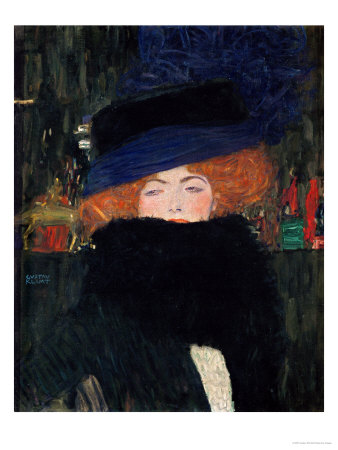 |
| Pallas Athene |
We see a girl on the verge of womanhood, her body elongated to proportions that could fit either an exceptionally tall girl or a grown woman reasonably well. If not for the narrowness of her shoulders it would be a perfect fit with her future self. She stands now like a bulb in a garden, against a garden wall.
Here Klimt’s decorative treatment of the background finds its fullest match with his subject matter. His pseudo-Byzantine flattening of the plane behind the figures sometimes seems like mere mannerism, like empty decoration. But here it embodies what is happening to the title character. It is blossoming, and she is blossoming. His later sketch after the painting makes this visual-symbolic gesture even more clear: here the idea of Mada stretched vertically beyond the literal truth and rapid stalks of black vertical lines emphasize this moment in every young girls life.
 |
| Detail from Mada Primavesi |
 |
| Judith |
So what makes Mada different? I’ll exercise one of my own favorite acid-tests to give, at least, my reasoning. Imagine if the image of Mada were to be slipped behind an advertisement on the street, perhaps Children’s clothes. Now imagine the earlier image of Judith being put through the same repurposing, perhaps in a spot for a new nightclub. Which would be more effective as advertising? And why? Well, for me, I would think the Judith would serve the admen better. It appeals immediately to our senses with asking nothing from our sympathetic understanding of humanity. It screams “sex” but not necessarily from Judith’s perspective, forgetting the nominal appearance of Holofernes’s head in the dim right corner. She is soliciting us. Like all advertising, it is about us.
 |
| Lady With Hat and Feather Boa |
Mada is complex. And it’s interesting that Klimt’s most complex images of women happen when he is furthest from his own sexual fantasies or the demands of a portrait-consuming elite (Mada herself did not commission this image, so she couldn’t sway Klimt‘s artistic vision the way his usual patron could). The images of the Lady Black Feather Hat and the Lady with Hat and Feathered Bow also poses this interiority, but for different reasons. Notably, neither makes eye contact with the viewer--neither acknowledges us. Both can almost be seen to be posing for someone else, someone standing to their right, and in the case of Lady with Hat and Feather Boa this posing almost takes the form of self-parody, with her debonair look barely creaking through the muffled mute of enveloping black clothes. Mada, however, does look at us. But she wants nothing from us--Unlike Adele-Bloch Bauer she is not posing for us. She is posing, but the pose seems to be part of her attitude, of her life at that moment. One gets the sense that she could be caught making a similar expression even if she were entirely alone.
Klimt took the commission to paint the portrait of a girl, and transformed his task into painting a portrait of all girls. That simultaneous tightening and widening of the scope--tightening on the peculiar emotional situation of the subject and widening by its truth in depiction to all our individual experiences it can apply to--is the lone common mark of all great art.
 |
| Photograph of Mada Primavesi |

No comments:
Post a Comment